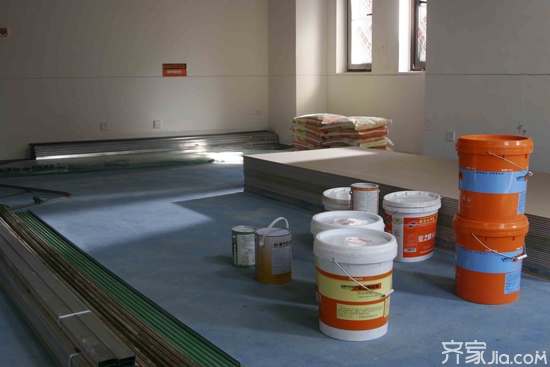Renovation is divided into hard-packing and soft-packing. The hard-packed parts require a large amount of materials. The types involved are numerous and the most tangled issue is how much to buy. To buy more, you need to spend more money, resulting in waste; buy less, when the decoration is not enough, you have to go buy, one to two to delay the construction period. The following will teach you how to estimate the amount of material used for reference only.

1. The consumption of labor, materials and machinery in the decoration budget is the main indicator in the budget quota. The calculation formula is as follows:
◆ Fixed labor costs = fixed number of working days × daily wage standard
◆ Fixed material fee = material quantity × material budget price + loss fee + transportation fee + equipment fee + management fee + tax
Due to the different material prices in different parts of the country, the decoration costs are not the same, but the calculation formula for the amount of decoration works is the same. In the case of decoration, the amount of materials can be calculated according to the calculation formula in the following example.
2, floor tile usage: (Note generally different room type loss rate is about 1-5% different)
◆Usage per 100 meters=100/[(block length + gray seam width)×(block width + gray seam width)]×(1+loss rate) For example, the retro floor tile size is 0.5×0.5M, and the seam width is wide For 0.002M, the loss rate is 1%.
For example, the required number of blocks for 100 m2 is: 100 m2 = 100/[(0.5 + 0.002) x (0.5 + 0.002) x (1 + 0.01). About 401 blocks.
Tile total price = number of floor tiles × floor tile unit price
3, ceiling usage:
◆Amount of ceiling plate=(length-shield length)×(width-shield width)
For example: Calculate the amount of PVC plastic ceiling in net size area. The unit price of PVC plastic sheet is 50.81 yuan per square meter, the shield length and width are 0.24M, the length of the canopy is 3M, and the width is 4.5M. The dosage is as follows:
The amount of ceiling plate = (3-0.24) x (4.5-0.24). About equal to 11.76 per square meter.
4, package door dosage:
◆Dosage of door material used = length of door outer frame × width of door frame
For example: use composite wood package door, door frame length 2.7M, width 1.5M, the amount of material is as follows:
Package door material dosage=2.7×1.5=4.05 square meters
5, wallpaper usage:
◆ Wallpaper Usage = (High - Shielded Length) × (Width - Shielded Width) × Walls - Door Area - Window Area
For example, the wall surface is calculated with a net size, the shielding is 24CM, the wall height is 2.5M, the width is 5M, the door area is 2.8 square meters, and the window area is 3.6 square meters, the dosage is as follows:
Wallpaper usage = [(2.5-0.24) x (5-0.24)] x 4-2.8-3.6, approximately equal to 36.6 square meters.
The above is a calculation of the amount of materials used, and the total material cost of the renovation project is calculated by multiplying each part of the decoration materials by their respective unit prices.
6, floor dosage: (solid wood)
â—†Vertical usage=room length/tile length
â—† lateral usage = room width / floor tile width
If they are not exhausted, they must use the carry-in method, but they must not be rounded, but in the longitudinal direction, they are not half a block, and half of them are counted.
◆ Total floor price = total usage × unit price
â—† floor loss = floor area - housing area
â—† floor loss rate = floor loss / housing area
Note: The general floor loss rate is not more than 5%
7, wall material usage
After determining the color variety of the wall material, the size of the material can be reasonably calculated according to the size of the living room. Considering the possible loss during construction, it can be purchased with about 5% more than the actual amount. There are two ways to calculate wall materials:
1. Calculated by the formula, the area of ​​the room is multiplied by 2.5, and the product is the number of materials used for the wall. Such as 20 square meters of room materials used for 20 × 2.5 = 50m.
2. On-site measurement, this method is more accurate, first understand the width of the wall material to be selected, measure the perimeter of the room wall (excluding doors, windows, etc.) according to the width, there are several wall materials in the perimeter Width, that is, a few stickers. Then measure the height of the wall that should be affixed. Multiply this by the number of walls, which is the length (in meters) of wall material required for the wall outside the door and window. Finally, the length of material required for the wall under the window, irregular corners, etc. is measured by this method, and it is added to the calculated length, which is the total length. This method is more suitable for fine-grained patterns, without special alignment of the wall material when splicing.
8, coating amount estimation method
Introduce a simple calculation method:
â—† When the room area (square meters) is divided by 4, the height of the wall to be painted (in decimeters) is divided by 4, and the combined number of the two is the number of kilograms of paint required.
For example, a room with an area of ​​20 square meters and a wall height of 16 decimetres (except a 12-meter wall skirt), then, is (20/4)+(16/4)=9, ie 9 kg of paint can be painted on the wall two all over.
Decoration material knowledge
1M Mini Measuring Tape,Small Retractable Tape Measure,Precision Tape Measure,Tape Measure Scale
SHANGQIU CHAOYUE MEASURING TOOLS CO., LTD , https://www.calibrateds.com
![<?echo $_SERVER['SERVER_NAME'];?>](/template/twentyseventeen/skin/images/header.jpg)